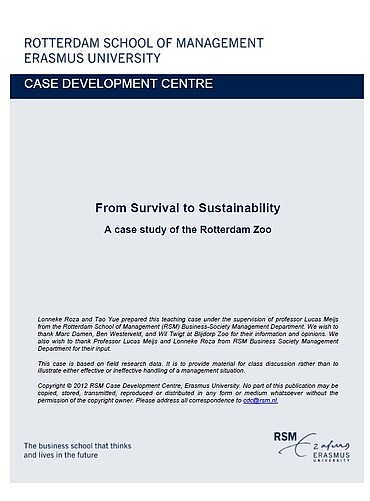Citation Note
Based on field research; 12 pages.
Follow the 'handle' link to access the Case Study on RePub.
For EUR staff members: the Teaching Note is available on request, you can contact us at rsm.nl/cdc/contact/
For external users: follow the link to purchase the Case Study and the Teaching Note.
Objective
The case is situated in a European country where the government traditionally subsidizes NPOs like the Rotterdam Zoo. It can be used to discuss innovative approaches to financing traditional NPOs, where the extra caveat in this case is that “fees for service” is already a substantial part of the income. So the innovation here is about diversifying with rather traditional non-profit funding sources in an organization and (community) environment that is not already used to doing this. As a consequence, this case serves four main teaching objectives: 1. Understanding the risks of a non-diversified funding base for a NPO a) Short-term vulnerability when a funding source stops; b) The need for a long-term strategic financial strategy; c) The need for grooming future funders and funding sources that can step in when a large funder leaves. 2. Understanding the complexity of maintaining a non-profit mission while having for-profit opportunities. a) Limits to for-profit behavior and funding; b) Limits to non-profit behavior and funding. 3. Understanding the complexity of organizational change after 20 years of existing in a very stable environment. a) Need to start thinking creatively about funding sources; b) Need to see the mission of the organization from a different perspective. 4. Understanding the need to have a more strategic discussion with community and business stakeholders about the position of an NPO in the local community and in the Corporate Social Responsibility (CSR) debate.
description
How to ensure that a non-profit organization’s dependency on funding does not get in the way of its mission? By examining the challenges the Rotterdam Zoo was facing when the municipal government drastically reduced its funding, the case addresses the general question many non-profit organizations are struggling with.
Abstract
How do you ensure that your nonprofit organization (NPO)’s dependency on funding does not get in the way of its mission? How do you predict what will happen to the NPO’s financial position with reasonable certainty? How can you create a resilient and sustainable funding portfolio for the short and longer run? How do you identify potential areas for fundraising? And how to ensure that your NPO stays relatively independent from its different sponsors? This case presents the challenges the Rotterdam Zoo faced in relation to the questions posed above. The Rotterdam Zoo enjoyed a stable income stream from visitors and the municipality for about 20 years. However, to have only one substantial additional source of income next to fees for service made the zoo vulnerable. When the Rotterdam municipality decided to drastically cut subsidies to the zoo, the zoo had no alternative funders to turn to. Apart from that, the zoo had limited experience and contacts for attracting donors, foundation money, or corporate sponsorship. If the zoo wanted to maintain its nonprofit mission, additional income above the fees for service, would be needed now and in the future.
usage
The case was initially used in an international students case competition. Later it was also used in teaching Bachelor and Master classes in business administration and public management. The case is suitable for general introduction courses on financial management, as most students will be able to understand the (financial) concept of a non-profit organization. It can also be used in more specific courses on non-profit management, social entrepreneurship, new public management, CSR, business-society management, and philanthropy.
